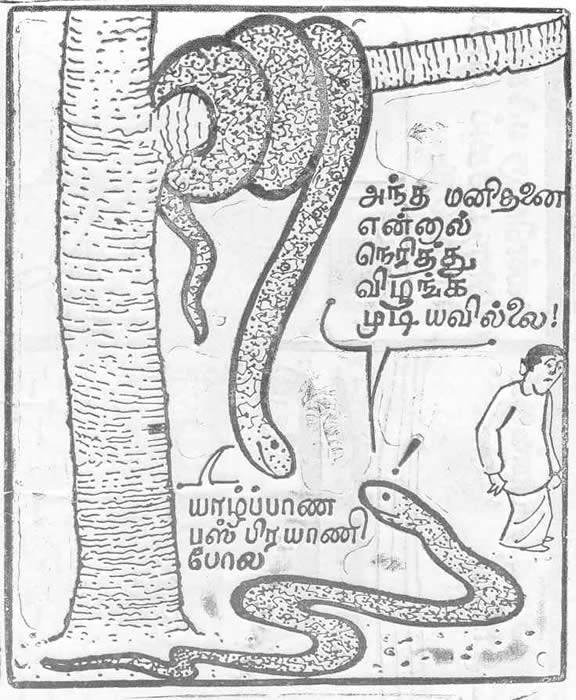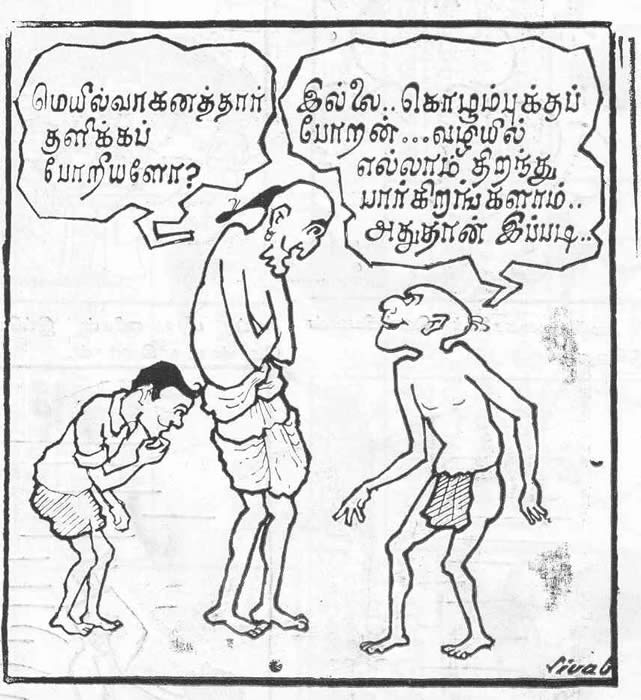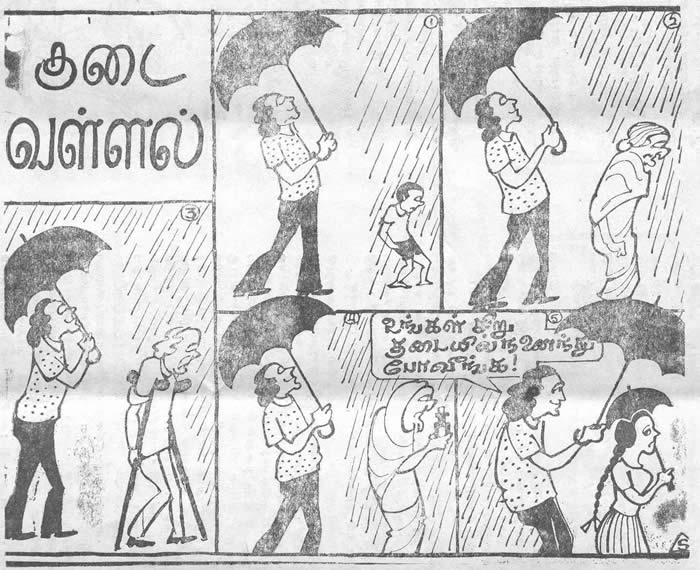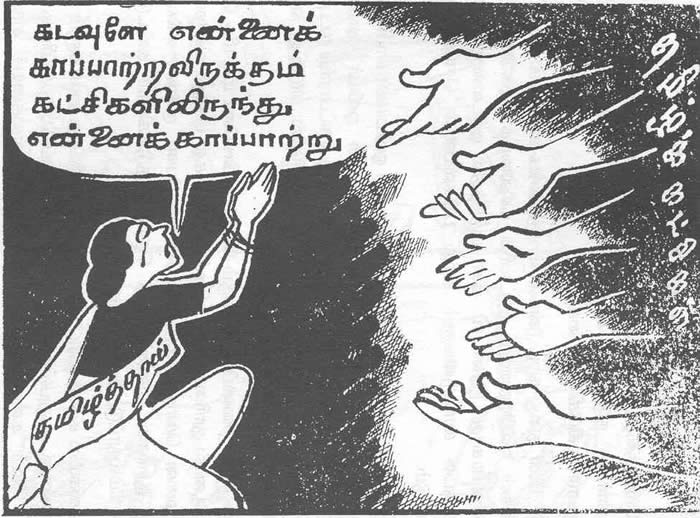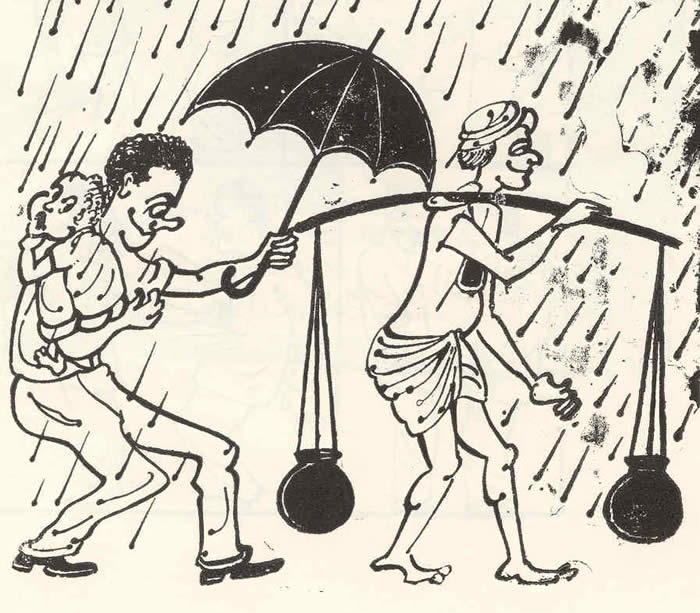Ilankai Tamil Sangam30th Year on the Web Association of Tamils of Sri Lanka in the USA |
||||||||||||||||
 Home Home Archives Archives |
'Sirithiran' SuntharThe Ace Cartoonist of Eelam Tamilsby Sachi Sri Kantha, March 3, 2008
March 3rd marked the 12th death anniversary of Sittampalam Sivagnanasuntharam (1923-1996), a uniquely creative personality who lived amongst us in the 20th century. Like so many English words which have been devalued by constant abuse, the word ‘creativity’ also has lost much sheen. One of the commonly accepted definitions for creativity is that “behavior or thinking that is both novel (original) and adaptive (useful)” [Gregory Feist, Creativity Research Journal, 1997; vol.10, pp.325-335]. Note that both components, novel (original) and adaptive (useful) are of relevance for creativity. While V. Anandasangaree’s recent creations of what he call “letters” may be considered as ‘novel (original)’ to a degree, these certainly are not ‘adaptive (useful)’ to anyone else other than the author. Thus, his “letters” are nothing more than ephemeral junk. As the ace cartoonist, and the creator of the ‘Savaari Thambar’ cartoon character, Sivagnanasuntharam possessed that elusive creative talent to make Eelam Tamils, irrespective of age barriers, chuckle at their follies and vanities. He simply did that by the strokes of his pen. And he continued to poke fun at Eelam Tamil society for 22 years, via his humor magazine Sirithiran. In its times, apart from the Mallikai magazine (the brainchild of Dominic Jeeva, with affinities to the Communist Party ideals) there were no competing local rivals to Sirithiran to engage in turf battles for readership. In Eelam, Sirithiran held its own against the weekly glossies (Anantha Vikatan, Kumudam, Kalki, Kalkandu) of the Madras moneybags and marched triumphantly from September 1965 to Oct.1, 1987. Even the Mallikai magazine of Dominic Jeeva did receive partial sponsorship in advertisements from loyal Communist Party enthusiasts. Conversely, Sirithiran strictly maintained its political independence. From what I heard, the arrival of the Indian Peace-Keeping Force (IPKF) in the Tamil homeland, and the subsequent crackdown by the intellect-challenged armed intruders, delivered the deathknell to Sirithiran, that was incapable of defending itself.
What type of a personality was Sirithiran Sunthar (Siva was another of his dimunitives)? Who were his influences in cartoon art? I have transcribed the details of an interview cartoonist Sunthar gave to V.N.S. Udayachandran for the Tamil journalWeekly Murasoli of May 20, 1990. Cartoonist Career: “I cannot call anyone as my mentor in cartoon art. But, I appreciate the cartoonist Mali, who draws for Anantha Vikatan magazine. In 1962, I drew a cartoon for the Bombay-based Blitz magazine. [This magazine was edited by Rusi Karanjia, who died on Feb.1, 2008, aged 95] The cartoon’s theme was two rats, with the faces of Winston Churchill and Nizam of Hyderabad, plotting against India. Before that, my cartoons also appeared in the journals like Conch (an Indian magazine), and Left-oriented Samasamajist, Trine (edited by Theja Gunawardena) and People’s Voice [edited by K.Vaikunthavasan]. After that my cartoons regularly appeared in the Tamil dailies and weeklies like Sutantiran, Thinakaran, Veerakesari, Eelamurasu and Murasoli.” On his alter-ego Savaari Thambar: “In Nelliadi village, there was one person named Savaari Thambar. In those days, he was a devout follower of Dravida Kazhagam party founder and social reformist E.V. Ramasamy Naicker. I modeled my cartoon character Savaari Thambar, based on this real person and used him as a mouth piece for propagation of social reform ideas (abolition of casteism and superstitions, cultural disintegration etc.).
Other Cartoon Characters: ‘I also created a character ‘Minor Machchan’ in the Mithiran daily, in which I poked fun on the pranks of teenagers. Then, in my humor magazine, Sirithiran, I created a feminine character ‘Mrs. Damodiran’. The creation of this character was based on my experience of sharing a rental house in Colombo. A Tamil couple in the adjacent room always communicated in a mixture of Tamil-English [Taminglish!]. An example is: ‘What is Kadai Sangam darling?’ Their use of ‘Kadai Sangam’ for Cooperative Stores was jarring. I couldn’t tolerate their assault on Tamil language, so I created this ‘Mrs. Damodiran’ to humor these semi-educated Tamils who insulted Tamil civilization.’ What is a Tamil translation for Cartoon?: ‘Cartoons are thought-providing. So, we can translate ‘cartoon’ into Tamil as a pun ‘karuthoon’ [karuthu= thought; Oon=food]. Friendship with Anton Balasingham: ‘The ideologue of Liberation Tigers, Anton Balasingham, is a close friend of mine. I expressed my view to him that, I’m incorporating the Question-Answers section in Sirithiran journal. Who can I ask to respond to the Questions. For this, Balasingham suggested that I should provide the answers, and not anyone else. Agreeing to this, then I wondered where should I gather the questions? Balasingham gave me a hand, and he asked the first three questions, that appeared in the second issue of Sirithiran journal (Oct.1, 1965). Here are the first three questions posed by Balasingham, and my three responses, offered under the pseudonym ‘Magudiaar’. [Magudi is the pipe instrument, traditionally associated with the snake charmers; thus, Magudiaar, is the one who uses Magudi].
This Question-Answer column of Sirithiran, initiated by the camaraderie between Anton Balasingham and Sivagnanasuntharam, became a sort of humorous Ann Landers column for the Eelam Tamils from the mid-1960s to the mid-1980s. Apart from the Question-Answer column, the jokes also humorously photographed the travails of life in Jaffna. Here are a few samples, in English translation:
*****
*****
*****
*****
*****
I provide below a short appreciation for Sivagnanasuntharam that I contributed to the Tamil Times (London) magazine when his first death anniversary approached. This piece was inspired from a chance meeting I had with the cartoonist’s maternal nephew in Tokyo in December 1996, who let me know that the man who made me humor-philic via his Sirithiran vehicle had died early that year. ‘Sirithiran’ Siva – An Appreciation [courtesy: Tamil Times, February 15, 1997, p.32] One year has passed since the death of Sittampalam Sivagnanasuntharam, the editor and publisher of Sirithiran, the foremost Tamil cartoon journal. Siva died on March 3, 1996, at the age of 72. He was the doyen of Tamil cartoon art form. He was a living example to the lines penned by the American poet Henry Wadsworth Longfellow:
‘Sirithiran’, an intellectual fruit, which blossomed from the Jaffna soil had its own culinary quality (sweetness and pungency) and cultured taste, similar to the food products like karuthakozhumban mango and chilli pepper, for which the Jaffna soil received its reputation. It held its own for over two decades against the competition of glossy magazines published by the media moguls of Madras. ‘Sirithiran’ could not afford the glossiness in its pages. But the Tamil magazines produced from Madras attested to Einstein’s humorous dictum that, ‘It’s not worth if the wrapper is of better quality than the meat it covered.’ Thus ‘Sirithiran’ found its precious niche and captured the life of Eelam Tamils humorously from many angles. Many other Tamil magazines which were established in Sri Lanka, aping the Madras glossies, folded within short duration, because they concentrated on the quality of the wrapper and not on the quality of the ‘meat’.
When ‘Sirithiran’ made its entry in mid-1960s, I was a school boy at the Colombo Hindu College, Ratmalana. A couple of my classmates bought each issue with their petty cash and most of us read each of those issues from cover to cover, surreptiously in between class periods. There was much discussion about the title, ‘Sirithiran’, which eludes a good one-word translation in English. The nearest equivalent is ‘Why don’t you laugh a little?’ – a powerful colloquialism used by the elder folks in Jaffna, when the young ones turn a sour face due to some mundane concerns; e.g: Konjam sirithiran raasaah! or Konjam sirithiran raasaathi!
‘Sirithiran’ Siva cut his journalistic teeth with his cartoon serial ‘Savaari Thambar’, which poked fun at the idiosyncracies of Eelam Tamils of all ages and all occupations. Like the karuthakozhumban mango and chilli pepper, the sayings of Savaari Thambar were ripe with sweetness and pungency. In those days, for thousands of Tamils, the day would not dawn without reading Savaari Thambar’s prophecy in the daily Tamil newspaper. Whatever the land-shaking news of the day in the front page, Savaari Thambar was the first (and probably only!) item many looked forward to read, day after day. That kind of reader loyalty tells something about the vitality of Siva’s artistic pen, which injected ‘vitamins’ to the routine and drab life many Tamils were forced to live in Jaffna peninsula and elsewhere in Sri Lanka. He poked fun at the behaviour of Tamils, without hurting or insulting their feelings. There is little doubt that the cartoon character and ‘Sirithiran’ created by Siva will live in the memories of Eelam Tamils for a long time.
***** |
|||||||||||||||
|
||||||||||||||||
